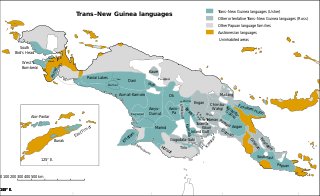
Trans–New Guinea (TNG) is an extensive family of Papuan languages spoken on the island of New Guinea and neighboring islands, a region corresponding to the country Papua New Guinea as well as parts of Indonesia.
Indo-Pacific is a hypothetical language macrofamily proposed in 1971 by Joseph Greenberg and now believed to be spurious. It grouped together the Papuan languages of New Guinea and Melanesia with the languages of the Andaman Islands and, tentatively, the languages of Tasmania, both of which are remote from New Guinea. The valid cognates Greenberg found turned out to be reflexes of the less extensive Trans–New Guinea family. Recently the Kusunda language, which is generally seen as a language isolate, is also included in the Indo-Pacific proposal. Greenberg did not include "Australian" in his original 1971 proposal.

The Trans-Fly–Bulaka RiverakaSouth-Central Papuan languages form a hypothetical family of Papuan languages. They include many of the languages west of the Fly River in southern Papua New Guinea into southern Indonesian West Papua, plus a pair of languages on the Bulaka River a hundred km further west.

Abom is a nearly extinct language spoken in the Western Province of Papua New Guinea. According to a 2002 census, only 15 people still speak this language. All of the speakers are older adults. Middle-aged adults have some understanding of it, but no children speak or understand Abom.
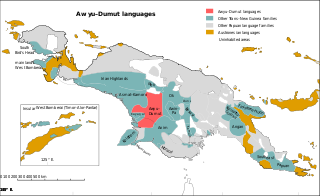
The Greater Awyu or Digul River languages, known in earlier classifications with more limited scope as Awyu–Dumut (Awyu–Ndumut), are a family of perhaps a dozen Trans–New Guinea languages spoken in eastern West Papua in the region of the Digul River. Six of the languages are sufficiently attested for a basic description; it is not clear how many of the additional names may be separate languages.
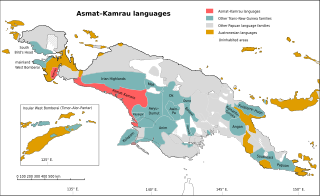
The Asmat – Kamrau Bay languages are a family of a dozen Trans–New Guinea languages spoken by the Asmat and related peoples in southern Western New Guinea. They are believed to be a recent expansion along the south coast, as they are all closely related, and there is little differentiation in their pronouns.

The Marind–Yaqai (Marind–Yakhai) languages are a well established language family of Papuan languages, spoken by the Marind-anim. They form part of the Trans–New Guinea languages in the classifications of Stephen Wurm and Malcolm Ross, and were established as part of the Anim branch of TNG by Timothy Usher.

The Inland Gulf languages are a family of Trans–New Guinea languages in the classifications of Stephen Wurm (1975) and Malcolm Ross (2005). The unity of the languages was established by K. Franklin in 1969. Although the family as a whole is clearly valid, Ipiko is quite distinct from the other languages.

The Kamula–Elevala languages are a small family of the Trans–New Guinea languages spoken in the region of the Elevala River.
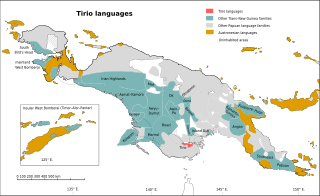
The Tirio languages are a family of Trans–New Guinea languages in the classification of Malcolm Ross. The Tirio languages have about 40% of their lexicon in common.

The Gogodala–Suki or Suki – Aramia River languages are a small language family of Papua New Guinea, spoken in the region of the Aramia River.
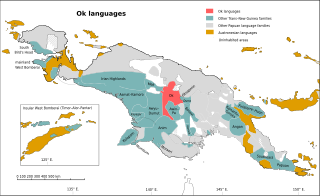
The Ok languages are a family of about a dozen related Trans–New Guinea languages spoken in a contiguous area of eastern Irian Jaya and western Papua New Guinea. The most numerous language is Ngalum, with some 20,000 speakers; the best known is probably Telefol.
The Yareban or Musa River languages are a small family of Trans–New Guinea languages spoken near the Musa River in the "Bird's Tail" of New Guinea. They are classified within the Southeast Papuan branch of Trans–New Guinea.

The Bulaka River languages are a pair of closely related Papuan languages, Yelmek and Maklew, on the Bulaka River in Indonesian South Papua. They are ethnically Yab (Jab); their speech is Yabga (Jabga).
Karami is an extinct and unclassified Papuan language of southern Papua New Guinea. It is attested from only a short word list, which include many loans from Foia Foia.

The Boazi languages, also known as the Lake Murray languages, are a pair of languages in the Trans–New Guinea family, spoken near Lake Murray. They were previously classified in the Marind branch.

The Central West New Guinea languages are a group of Trans–New Guinea families in central New Guinea established by Timothy Usher, though with precedents in earlier studies.

The Asmat–Muli Strait languages are a branch of the Trans–New Guinea languages spoken along the southern coast of Indonesian New Guinea, established by Timothy Usher and Edgar Suter.
Proto-Trans–New Guinea is the reconstructed proto-language ancestral to the Trans–New Guinea languages. Reconstructions have been proposed by Malcolm Ross and Andrew Pawley.
The Awyu–Ok languages are a group of Trans–New Guinea families in central New Guinea established by Timothy Usher, though with precedents in earlier studies.














